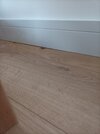- Joined
- 11 Sep 2023
- Messages
- 8
- Reaction score
- 0
- Country

Hey all, we recently renovated our first house (built 1930s) with the help of a local builder. As part of this we removed the chimney breast (unfortunately not properly capped when we purchased the property) from the ground up and that area was dot and dab replastered and MDF skirting installed. 3 months on despite using a dehumidifier when needed to keep moisture levels down, there is green and white mould that keeps coming under the skirting. Is this from the years of the chimney being not properly capped, damp coming out from the plastering (was very very humid in the house when this was happening) or anything else? Currently thinking of taking the skirting off and trying to mould treat, try and dry it out and then replace with solid wood skirting. Any thoughts as to whether this is best course of action?


